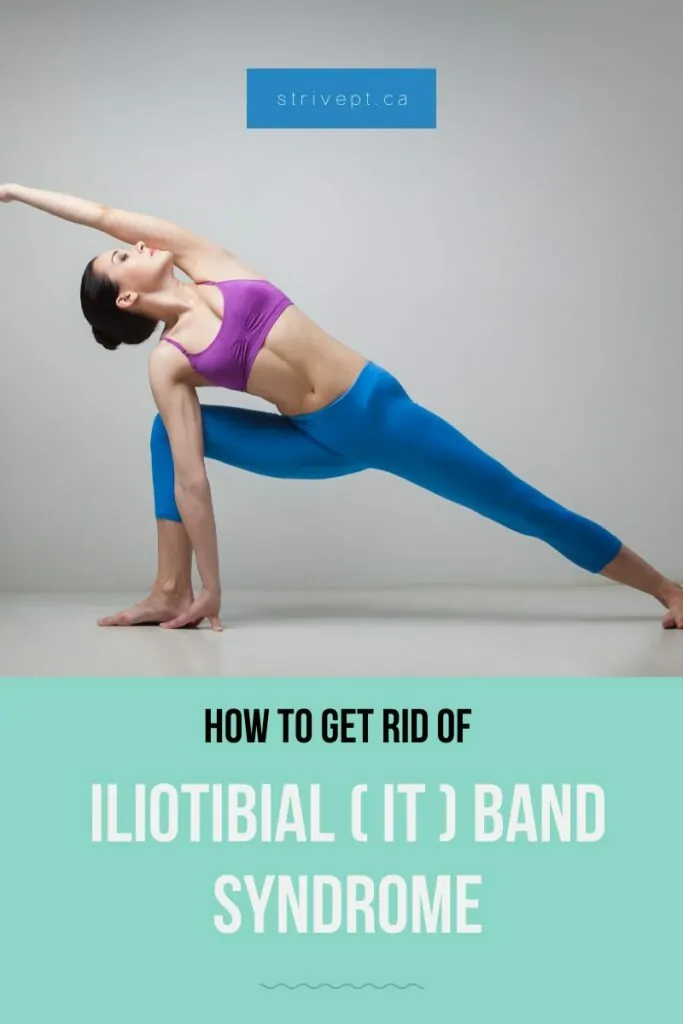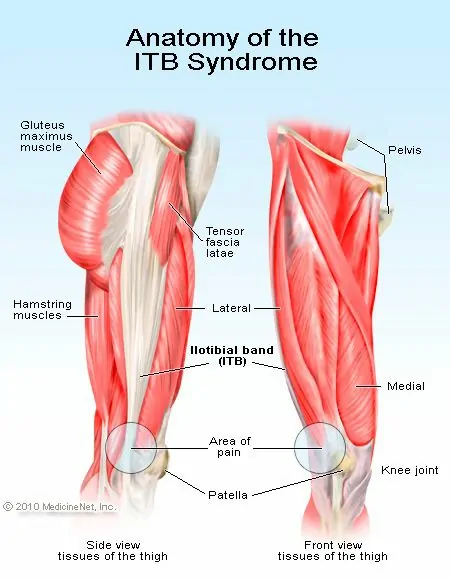
Have you experienced a nagging pain in the side of your knee? Are you someone who exercises regularly, but that pain seems to actually get worse with exercise? Well, today I am going to show you what might be causing that pain and why it hasn’t gone away yet. Let’s take a look at some relevant anatomy first.
Iliotibial band syndrome is one of the most common causes of lateral knee (outside of your knee) pain in athletes, and is common in exercising adults as well. The iliotibial (IT) band is a long band of fibrous connective tissue that runs down the side of your leg from your hip to your knee. At the hip, the front outer hip muscle (tensor fascia latae), gluteus maximus, and gluteus medius muscles connect to the IT band. As the IT band runs down the side of your leg, part of your quad muscles (the vastus lateralis muscle) connects to it from the front of your thigh, while part of your hamstring (the biceps femoris muscle) connects to it from the back of your thigh. As the IT band reaches the outside of your knee, it connects to your kneecap (patella) and a part of your shin bone (tibia).
What is causing the IT band pain?
While it is hard to determine the exact cause of IT band pain, one theory is that excessive friction leads to pain. This theory is based on the idea that the IT band moves forward and backward during repetitive knee bending and straightening. This repetitive movement could create friction as the IT band moves over the thigh bone (femur), which could lead to irritation and pain at the lateral knee. Another common theory is that the IT band becomes painful when compressed. Frequent or excessive compression of the IT band through repetitive use or trauma can cause it to be irritated and create pain.
Should I stretch or foam roll the IT band?
While a common approach to IT band syndrome is to stretch or foam roll the IT band in hopes to lengthen it, research shows that this connective tissue cannot be easily changed. The IT band is extremely stiff and strong, so stretching or foam rolling it will not change it. That being said, stretching or foam rolling the muscles around the IT band can be helpful. As mentioned earlier, the glute medius and maximus, tensor fascia latae, vastus lateralis, and biceps femoris all attach to the IT band. As such, foam rolling or stretching any of these muscles may be helpful in treating IT band syndrome.
How do I get rid of my IT band pain?
It is important to always see a healthcare professional to receive a proper diagnosis and treatment plan that fits your individual needs when dealing with an injury. The following information can be helpful in improving your symptoms if you are experiencing IT band syndrome.
Step 1: Activity modification
The first strategy to help with your injury is activity modification. With IT band syndrome, there is usually an activity that will increase your pain. Continuing to perform activities that aggravate your injury will make it difficult for it to heal. Think of it like poking a bruise. As long as you keep poking, it will be much harder for that bruise to heal and stop hurting. This doesn’t mean you need to stop the activity completely, but rather decrease the amount that you are engaging in. For example, if you have been running every day, and it increases your pain, you may have to reduce your running to every other day while this injury heals.
Step 2: Stretching or foam rolling
The next strategy to help get rid of IT band pain is to improve the mobility of structures around the IT band. As mentioned previously, this can be done through stretching or foam rolling the quadriceps, hamstrings, glutes, and tensor fascia latae. It is also important not to stretch or foam roll into pain, as this may aggravate your injury. Instead, try very gentle foam rolling and stretching with short holds, such as five seconds.
Step 3: Strengthening
After modifying your activities and starting to stretch or foam roll the muscles around the IT band, the next step is to begin strengthening some of those muscles. A physiotherapist can help you determine which muscles would be best to strengthen, but the gluteus maximus and medius are commonly weak muscles. Two exercise options to strengthen those muscles are the bridge and the clamshell, as pictured below.
In the bridge exercise, you start lying on your back with your knees bent so that your feet are flat on the ground. Next, push into the ground, squeeze your glutes, and lift your hips up into the air. This exercise should be pain-free, so you should only lift as high as you can without pain.
For the clamshell exercise, start lying on your side with your hips stacked on top of each other and your shoulders stacked as well. Bend your knees and hips slightly. Next, lift your top knee up towards the ceiling while keeping your feet together. It is important to keep your hips stacked on top of each other so that your body is not rotating. The movement will be small, but you should feel your glutes working. You can also add a resistance band around your knees to make it more challenging and incorporate holds at the top of the movement.
Still not sure what to expect with your injury? Call us at 519-895-2020, or use our online booking tool on www.strivept.ca to book an appointment with one of our knowledgeable physiotherapists, and they will be sure to help you understand your injury.
Cheers,
Liam Newlands
Physiotherapy Resident at Strive Physiotherapy & Performance


